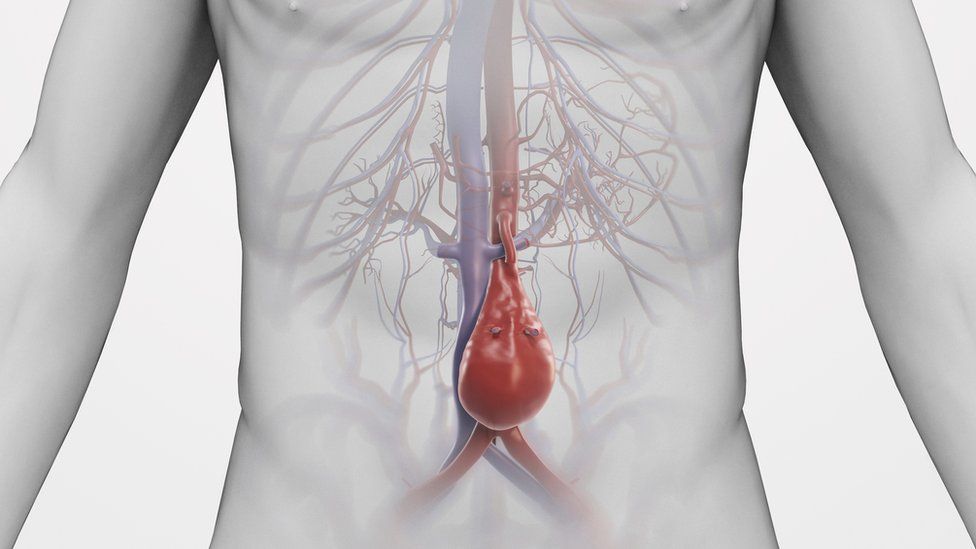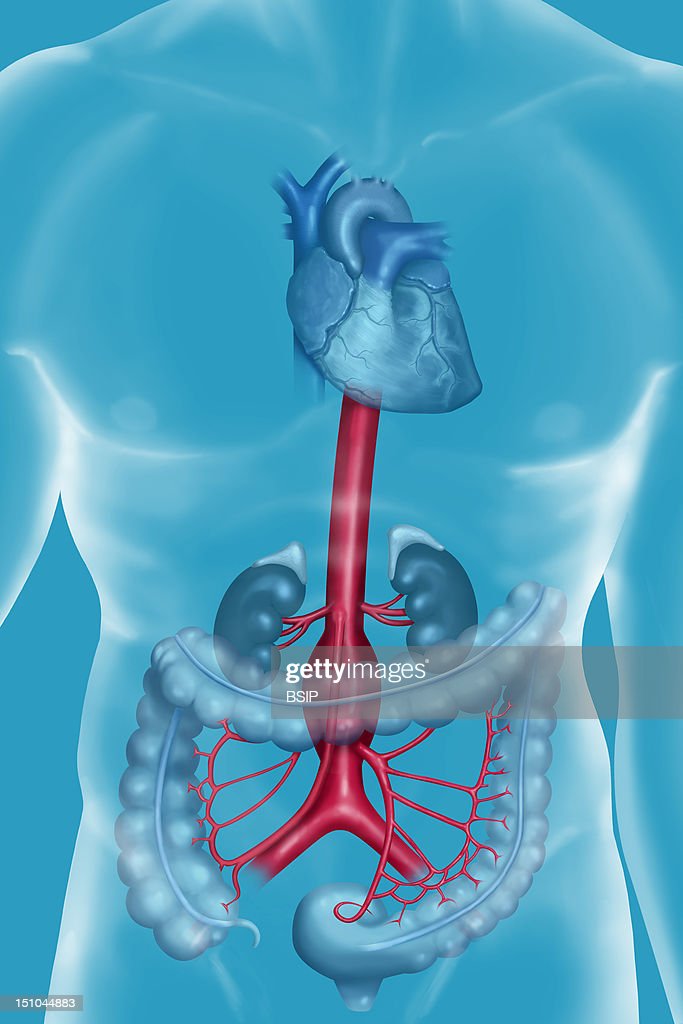How Is An Abdominal Aortic Aneurysm Treated
Treatment depends on a variety of factors, including size and location of the aneurysm within the abdominal aorta and the patient’s age, kidney function and other conditions.
Patients with aneurysms that are smaller than five centimeters in diameter are typically monitored with ultrasound or CT scans every six to 12 months and may be advised to:
- quit smoking
Surgical treatment may be recommended for patients who have aneurysms that are:
- larger than 5 centimeters in diameter
- quickly growing
There are two treatment options:
- Traditional surgical repair: In this type of surgery, an incision is made in the abdomen and the damaged part of the aorta is removed and replaced with a synthetic tube called a stent graft, which is sewn into place.
- Endovascular surgery: In this procedure, which is less invasive than an open repair, the stent graft is attached to the end of a thin plastic tube called a catheter, inserted through an artery in the leg and maneuvered up into the abdomen, where it is positioned inside the aneurysm and fastened in place with small hooks.
Abdominal Aortic Aneurysm: How To Spot Early Signs And Symptoms
An aneurysm occurs when an artery wall becomes weakened, and the pressure of blood flow stretches it thin. The stretching results in a fragile bulge in the artery that, if ruptured, can lead to fatal internal bleeding. Aneurysms most often occur along the aorta. Abdominal aortic aneurysms are usually small and donât cause many noticeable symptoms. As a result, â15,000 people die from abdominal aortic aneurysmsâ each year.
Who Gets Abdominal Aortic Aneurysms
White men over 65 are the most likely to get AAA. Additional risk factors include:
- Being a woman over 70.
- Personal history of an aneurysm in another site, especially in your lower extremities.
- Family history of AAA .
- Traumatic injuries that cause tears in the artery wall.
- Tobacco use causes loss of structural proteins in the artery wall, leading to reduced wall strength.
- Vasculitis .
Research suggests AAA may also relate to genes you inherit from your parents. Some genetic diseases that affect connective tissues, such as or Ehlers Danlos type IV, can also cause blood vessel weakness or damage. These conditions more commonly affect the aorta in the chest but also the abdominal aorta.
Read Also: Does Menopause Cause Stomach Bloating
What Are The Causes
Doctors donât know exactly why abdominal aortic aneurysms happen, but they do know several things that can play a part:
- Smoking and using other types of tobacco
- Hardening of your arteries, which is called atherosclerosis
- People with a family history of the condition
Also, your chance of having this condition is higher if you have had an aneurysm before.
If your odds of getting an aneurysm are high, you might want to talk with your doctor about a screening.
When Is Abdominal Aortic Aneurysm Treatment Needed And What Are The Treatment Options

We usually repair the aorta when an aneurysm reaches about 5 or 5.5 centimeters in width. There are two general approaches we can take to repair aneurysms. One is with a standard, open abdominal surgery that has been done for many years. This type of surgery is successful in repairing the aneurysm, however is a much more intensive procedure. This technique is often used for more complex patients who require standard surgical methods because their aorta needs to be shaped in a certain way to be successful. The second approach has been developed more recently over the past two decades. It’s an endovascular technique in which the aneurysm is repaired in a much less invasive manner. A lot of aneurysms can now be treated with an endovascular procedure and about 90 percent of the patients we see at UChicago Medicine are able to have their aneurysm fixed with stents.
Read Also: What Kills Parasites In Your Stomach
What Are The Symptoms
You might not even know you have this condition because it often doesnât have any symptoms. Some aneurysms start out small and get bigger gradually. Others grow quickly, and some never grow at all.
If yours is growing, you may feel:
- Pain deep inside, or on the side of, your abdomen
- Sudden, severe back pain
- A pulsating feeling in your abdomen
If you have any of these signs, see your doctor immediately or call 911.
When Is Surgery Recommended For The Treatment Of Abdominal Aortic Aneurysm
Large abdominal aortic aneurysms may rupture unexpectedly. Surgery can prevent that from happening, but carries risks of its own. So its important to carefully consider the pros and cons of surgery before making a decision.
The larger an aneurysm is, the greater the chances are that it will rupture. It is estimated that an abdominal aortic aneurysm that is over 5.5 cm in diameter will rupture within one year in about 3 to 6 out of 100 men. That’s why surgery is often recommended. But there may also be good reasons to not have surgery.
Recommended Reading: What Makes Your Stomach Cramp
Lowering Risk For An Abdominal Aortic Aneurysm
The best thing you can do to avoid developing an aneurysm is to not smoke. Smoking is the most common cause of an abdominal aortic aneurysm as well as many other health problems. Exercising daily can also be beneficial, as can lifestyle changes that help lower your blood pressure. If you are at risk, donât put off talking to a doctor about steps you can take to protect your health.
How Is An Aneurysm Treated
Treatment typically depends on the location and type of aneurysm.
For example, a weakened area of a vessel in your chest and abdomen may require a type of surgery called an endovascular stent graft. This minimally invasive procedure may be used over traditional open surgery because it involves repairing and reinforcing damaged blood vessels. The procedure also reduces the chance of infection, scarring, and other problems.
Other treatments can include medications that treat high blood pressure and high cholesterol. Certain types of beta-blockers may also be prescribed to lower blood pressure. Lowering your blood pressure may keep your aneurysm from rupturing.
Don’t Miss: Can Blood Test Detect Stomach Cancer
Abdominal Aortic Aneurysm: What You Need To Know
-
Abdominal aortic aneurysm is sometimes known as AAA, or triple A.
-
Older, long-term smokers are at especially high risk for abdominal aortic aneurysm.
-
Many people have no symptoms and dont know they have an aortic aneurysm until it ruptures, which is often quickly fatal.
-
Symptoms, when they do occur, include pain in the back or near the naval. An extremely sharp and severe pain may indicate rupture, requiring emergency medical treatment.
-
Smaller, slow-growing aortic aneurysms may be treated with watchful waiting, lifestyle changes and medication. Large or fast-growing aortic aneurysms may require surgery.
What Are The Types Of Abdominal Aortic Aneurysms
AAAs are usually classified by their size and the speed at which theyre growing. These two factors can help predict the health effects of the aneurysm.
Small: or slow-growing AAAsgenerally have a much lower risk of rupture than larger aneurysms or those that grow faster. Doctors often consider it safer to monitor these with regular abdominal ultrasounds than to treat them.
Large: or fast-growing AAAsare much more likely to rupture than small or slow-growing aneurysms. A rupture can lead to internal bleeding and other serious complications. The larger the aneurysm is, the more likely that it will need to be treated with surgery. These types of aneurysms also need to be treated if theyre causing symptoms or leaking blood.
Treatment for an abdominal aortic aneurysm may vary depending on your overall health and the size, exact location, growth rate, and type of aneurysm.
Treatment options may include :
- Open abdominal surgery. This procedure is used to remove damaged areas of your aorta. Its the more invasive form of surgery and has a longer recovery time, but may be necessary if your aneurysm is very large or has already ruptured.
- Endovascular surgery. This is a less invasive form of surgery than open abdominal surgery. It involves using a graft to stabilize the weakened walls of your aorta.
- Monitoring. For a small AAA thats less than 5.5 centimeters wide, your doctor may decide to monitor it regularly with imaging instead of performing surgery.
Read Also: Why Does My Weight Go To My Stomach
What Are Common Abdominal Aortic Aneurysm Causes
Research has shown us that there are specific propensities that pose the greatest risks for developing AAA, such as:
- High blood pressure
- High cholesterol
Family history can also play an important role in identifying your risk level. It has been shown that there are higher incidences of abdominal aortic aneurysms if one or more family members have been diagnosed with an AAA. However, this is not a forgone conclusion that you or your children will have an AAA simply because others in your family had an aneurysm. Understanding the risk factors for abdominal aortic aneurysm and having regular exams to monitoring your cholesterol and blood pressure are important preventive measures that can lower your chances of having a severe AAA.
How Serious Is An Aneurysm In Your Stomach

The occurrence of an aneurysm in the stomach is a serious issue. Attending to it immediately is vital to prevent rupture of the same. An aneurysm is a formation of a balloon-like structure at the weakest region on the wall of the aorta. The balloon-like structure forms because of the high flow of blood pumped by the heart through the aorta.
The growth of an aneurysm is slow. However, after a specific value of the dimension, it ruptures and causes spillage of blood into the surrounding region. It not only creates a disturbance to the usual flow of the blood, but also damages the surrounding nerves and arteries.
Recommended Reading: How To Get Rid Of Cellulite On Stomach At Home
Why And When Would I Need An Abdominal Aortic Ultrasound
If you have a family history of AAA, you should start getting screened at age 50. If your first screen is normal, I usually recommend you get checked again in 10 years. I really stress with my patients that they should let family members know how important it is that they get screened as well. I’ve had a number of brothers and sisters, as well as children of the appropriate age, come in to get screened, and we’ve been really conscientious about promoting the family history aspect of it for follow up evaluation. If you do not have a family history but do have AAA risk factors , we suggest you begin screening at age 65. If you have a normal screening, it is likely that you will never have to be checked again. However, if your aorta is a little enlarged, we will recommend rechecking once a year, or every other year, until the AAA grows to a size where we need to check it more frequently.
Is Someone Likely To Get An Aneurysm A Second Time After Its Treated
There is a low risk of having a second aneurysm. Though rare, you might develop an aneurysm in a different location on the aorta, or you could experience a problem with the original aneurysm repair. Thankfully, there’s little likelihood of having an issue that requires intervention, but we do follow our patient post-treatment, usually once a year, sometimes every six months, to make sure that other problems aren’t developing.
Recommended Reading: What’s The Best Way To Lose Your Stomach
Aaa Treatment At University Of Michigan Health
The Comprehensive Aortic Program at the Frankel Cardiovascular Center is one of the highest volume centers for abdominal aortic aneurysm in Michigan. With nine physicians dedicated to providing the highest quality of care for abdominal aortic aneurysms, our multidisciplinary program brings together a team of specialists to review complex cases and create the best treatment plan for each patient.Our experts can manage complex aortic disease including abdominal aortic aneurysm and all conditions associated with it, including:
- Aortic infection
- Penetrating ulcer with pseudoaneurysm
- Post-traumatic aneurysm
- Small aneurysms that thrombose
Not all patients with abdominal aortic aneurysms require immediate surgical treatment. We can provide comprehensive care and monitor the progressions of these aneurysms until surgery becomes necessary.
If You Have A Small Or Medium Aaa
If you are diagnosed with a small or medium aneurysm, you wont be referred to see a vascular surgeon, as its unlikely youd benefit from surgery.
Youll be invited back for regular scans to check the size of the aneurysm, in case it gets bigger every year if you have a small aneurysm and every three months if you have a medium aneurysm.
You will also be given advice on how to prevent the aneurysm from getting bigger, including:
- stopping smoking
- ensuring you maintain a healthy weight
- taking regular exercise
If you smoke, the most important change you can make is to quit. Aneurysms have been shown to grow faster in smokers than in non-smokers.
Read more about stopping smoking and nicotine replacement therapies that can make it easier to stop smoking.
Your GP will be sent your test result and may decide to change your current medication or start you on a new one, especially if you have:
- high blood pressure which you will probably be treated for with a medication called an angiotensin-converting enzyme inhibitor
- high cholesterol which you will probably be treated for with a medication called a statin
Recommended Reading: How Do I Tighten Loose Skin On My Stomach
What Causes An Abdominal Aortic Aneurysm To Form
Many things can cause the breakdown of the aortic wall tissues and lead to an abdominal aortic aneurysm. The exact cause isn’t fully known. But, atherosclerosis is thought to play an important role. Atherosclerosis is a buildup of plaque, which is a deposit of fatty substances, cholesterol, cellular waste products, calcium, and fibrin in the inner lining of an artery. Risk factors for atherosclerosis include:
-
Family history
-
Genetic factors
-
Connective tissue disorders such as , Ehlers-Danlos syndrome, Turner’s syndrome, and polycystic kidney disease
-
Congenital defects such as bicuspid aortic valve or coarctation of the aorta
-
Inflammation of the temporal arteries and other arteries in the head and neck
-
Infection such as syphilis, salmonella, or staphylococcus
What Causes Aortic Dissection
The cause of aortic dissection is unclear. However, several risk factors associated with aortic dissection include:
-
High blood pressure
-
Connective tissue disorders, such as Marfan’s disease, Ehlers-Danlos syndrome, and Turner’s syndrome
-
Cystic medial disease
-
Atherosclerosis
-
Bicuspid aortic valve
-
Coarctation of the aorta
-
Excess fluid or volume in the circulation
-
Polycystic kidney disease
Read Also: What Are The Odds Of Surviving Stomach Cancer
Abdominal Aortic Aneurysm Repair
AAA – open Repair – aortic aneurysm – open
Open abdominal aortic aneurysm repair is surgery to fix a widened part in your aorta. This is called an aneurysm. The aorta is the large artery that carries blood to your belly , pelvis, and legs.
An aortic aneurysm is when part of this artery becomes too large or balloons outward.
What Causes An Aaa

Doctors dont know exactly what causes an AAA. Weaker aorta walls increase your chance of developing an aneurysm. There are many conditions that can weaken the walls of the aorta. These include aging, smoking, and high blood pressure. If any of the following factors apply to you, you are at higher risk of having an AAA.
- Being male. Men are more likely than women to develop an AAA.
- Age. AAAs are more common in people age 65 or older.
- Personal history. If you have had aneurysms of any kind, you are at greater risk of an AAA.
- Habits. Smoking damages and weakens the aorta walls.
- High blood pressure. Having high blood pressure weakens the walls of your aorta.
- Family history. If any family members have had AAAs, you are at higher risk. You also could get an AAA before you are 65.
Talk to your doctor if you have a higher risk for an AAA, or if you have any of the symptoms.
You May Like: How To Stop Bad Stomach Cramps
What Surgical Techniques Are Used
There are two techniques used to operate on an aneurysm:
- Open surgery through an abdominal incision
- Endovascular surgery through a small incision in the groin
Surgical techniques for abdominal aortic aneurysm
In Germany, about 20 out of 100 patients have open surgery and 80 out of 100 have endovascular surgery.
Symptoms Of An Unruptured Abdominal Aortic Aneurysm
Abdominal aortic aneurysms are slow-growing and often do not cause symptoms, making them difficult to notice. Many never get big enough to have any effect. However, some expand more quickly, increasing the risk of rupture. Because a ruptured aneurysm puts your life in jeopardy, it is best to monitor any aneurysm that has been detected carefully for growth.
If you do have symptoms before the aneurysm ruptures, they may include tenderness and pain in the area just below your navel. You may feel a pulsing as well, like a heartbeat in your abdomen.
Experiencing sudden or severe pain in your lower back may also be a sign of abdominal aneurysm. Loss of appetite or upset stomach sometimes accompanies these symptoms.
- Abdominal aortic aneurysms are slow-growing and often do not cause symptoms, making them difficult to notice.
- If you do have symptoms before the aneurysm ruptures, they may include tenderness and pain in the area just below your navel.
Read Also: Why Does My Stomach Hurt When I M On My Period